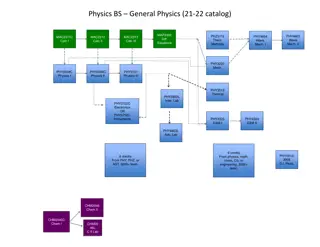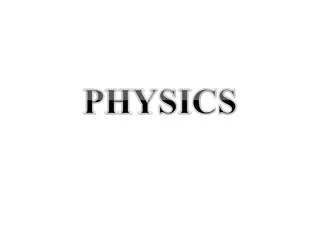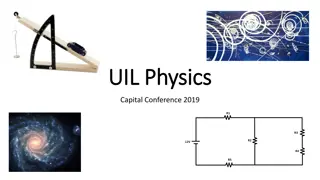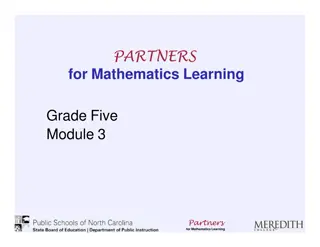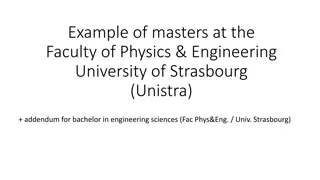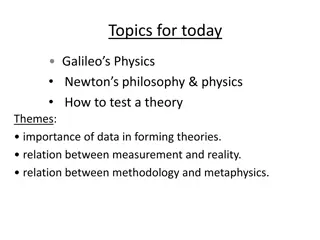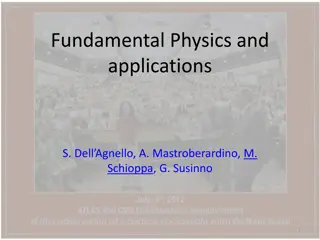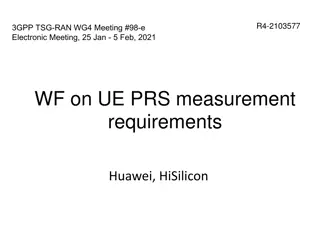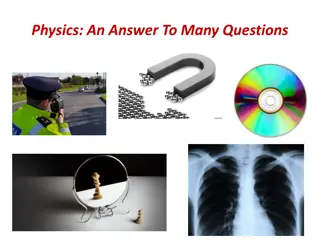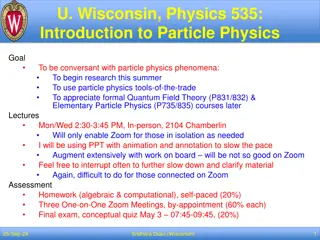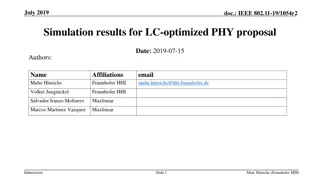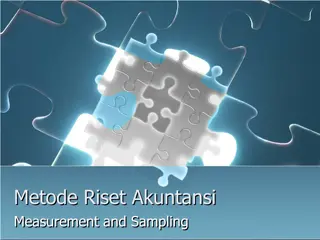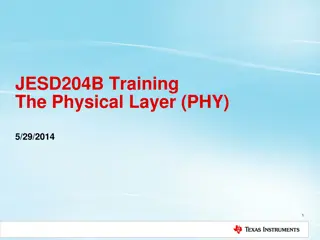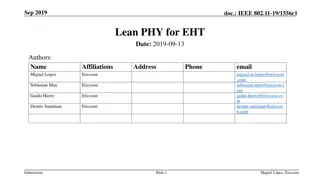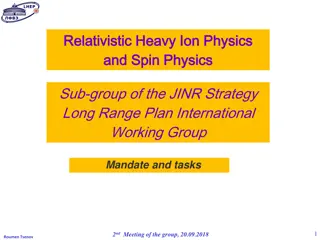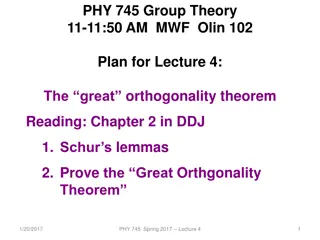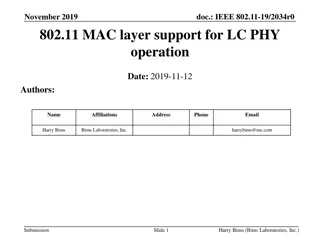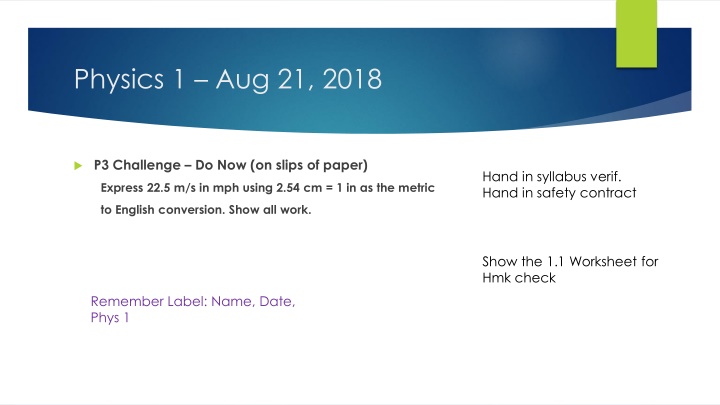
Understanding the Importance of Standards in Physics
Explore the significance of standards in physics, including the conversion from metric to English units and the role of SI units. Learn about the historical context and evolution of measurement standards in the field.
Download Presentation

Please find below an Image/Link to download the presentation.
The content on the website is provided AS IS for your information and personal use only. It may not be sold, licensed, or shared on other websites without obtaining consent from the author. If you encounter any issues during the download, it is possible that the publisher has removed the file from their server.
You are allowed to download the files provided on this website for personal or commercial use, subject to the condition that they are used lawfully. All files are the property of their respective owners.
The content on the website is provided AS IS for your information and personal use only. It may not be sold, licensed, or shared on other websites without obtaining consent from the author.
E N D
Presentation Transcript
Physics 1 Aug 21, 2018 P3 Challenge Do Now (on slips of paper) Hand in syllabus verif. Hand in safety contract Express 22.5 m/s in mph using 2.54 cm = 1 in as the metric to English conversion. Show all work. Show the 1.1 Worksheet for Hmk check Remember Label: Name, Date, Phys 1
Agenda Agenda for IB 1.1 Measurement in physics Standard operating procedures About Numbers Homework Review, p 1-4 Measuring Standards Significant figures Metric units Scientific Notation Dimension Analysis Calculations with sigfigs Estimation Unit conversion Assignment: IB 1.1 Measurement in Physics Practice Sheet, Estimates, Read 1.2
Standards Why need standards? Consider a world without standards Good standards A) Unchanging over time and B) Accessible everywhere Poor standards Ex: yard comes from the Saxon word "gird" meaning the circumference of a person s waist (National Institute Of Standards And Technology) IUPAC (International Union of Pure and Applied Chemistry) The world authority on chemical nomenclature, terminology, standardized methods for measurement, atomic weights and other critically evaluated data.
English System Complex relationships between units Historical standards are anecdotal Current standards are defined in terms of SI units Ex: 1 foot = exactly 0.3048 m Treaty of the Meter 1875 Metric Conversion Act of 1975 Preferred official system 1988 2017, we re still teaching English units
SI (or metric) System Standard for time 1 second is defined as the duration of 9, 192, 631, 770 periods of the radiation (light) emitted from a certain transition in a cesium-133 atom. (Atomic clock) Though Cs-133 is not available everywhere, and it is not simple to make this observation, every cs- 133 atom would behave the same way.
SI (or metric) System Standard for length 1 meter is defined as the distance that light travels in vacuum in 1/299,792,458 s. Speed of light in a vacuum is a constant. Available everywhere. Depends on the standard of time.
SI (or metric) System Standard for mass 1 kilogram is defined as the mass of a singular cylinder of a platinum alloy that is housed in S vres, France, called the IPK (international prototype kilogram) K 20 (US official prototype) is a third generation copy each copy of a copy level creates additional error, though very small Pt chosen because it does not decay over time, so it is a relatively stable standard. https://www.youtube.com/watch?v=ZM ByI4s-D-Y World s Roundest Object IPK K20
SI (metric) System DERIVED UNITS BASE UNITS (all defined relative to the 3 standards above) Units for all other quantities besides the base For each new quantity we will discuss, we will learn about: meter for length kilogram for mass (note: not the gram) Name of the quantity (Ex: Force) second for time Symbol used to represent the quantity (Ex: F) ampere for electric current Name of unit used to measure the quantity (Ex: Newton) kelvin for temperature Symbol for the unit (Ex: N) candela for luminous intensity The unit expressed in base units (Ex: 1 N = 1 kg m s-2 ) mole for the amount of substance
Metric Conversions PREFIXES Ways to Convert: Prefix unit to base unit Allows units to be a convenient size for observations Replace prefix symbol with power of 10 Defined in terms of powers of 10 Ex: 540 nm = 540 x 10-9 m Common Prefixes to memorize Prefix Abbreviation Power of 10 Nano- Micro- Milli- m Centi- Kilo- Move the decimal place Often used with 3 orders of magnitude changes. n 10-9 10-6 10-3 10-2 103 Ex: 45.6 mL = 0.0456 L Factor Label methods using: # in meter stick: 1 m = 103 mm 1 mm = 10-3 m c k Definition:
Metric Conversions using prefixes Times sign, draw the line, copy the unit. The metric prefixes help you write conversion factors with the power of powers of 10! Conversions to and from meters: To create equivalences, replace the prefix of a metric unit name with the corresponding power of 10. Ex: 1 km =103 m; 1 pm = 10-12 m or 1 m = 1012 pm Conversions between other metric units: Convert to meters first and then to the target unit. Ex: km to cm
Dimension Analysis In physics, problems are often solved with the benefit of a formula that relates some number of quantities. The units for any formula must be consistent. Be able to verify the units for any formula by expressing all derived units in terms of base units. Ex: Knowing that Energy (E) is measured in Joules (J = kg m2 s-2), mass (m) is measured in kg, acceleration (a) is measured in m s-2, and distance (d) is measured in m, Verify that E = mad is a valid formula to use to describe the relationships between these variables.
Estimation Another common skill for any physics problem is to estimate the order of magnitude for your answer so you can judge whether your calculated answer is reasonable or not. To estimate, Round all quantities to (one sig fig with an order of magnitude) https://www.youtube.com/watch?v=0fKBhvDjuy0 Powers of 10 https://www.youtube.com/watch?v=jfSNxVqprvM Cosmic Eye Perform the needed calculation using your new simple numbers to find a one sigfig order of magnitude estimate of the answer. Ex: The wavelength of visible light is between 430 nm and 770 nm and the speed of light is 3.00 x 108 m/s. If the speed = frequency * wavelength, estimate the order of magnitude for the frequency of visible light.
Exit Slip and Todays Assignment Exit Slip Estimate the area (m2) available to each person if there are around 7 billion people and the earth has a radius of around 5000 km. Give a one sigfig order of magnitude estimate. Then describe this area in terms of the images shown in the videos. What s Due? (Pending assignments to complete.) IB 1.1 Measurement in Physics Practice Sheet, Estimation questions What s Next? (How to prepare for the next day) Read IB 1.2 p 7-20

